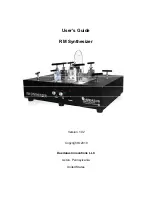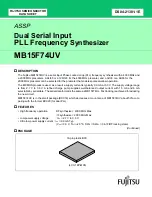
5-4
Descriptions of Parameters
Program Editor Parameters
These parameters control the
rate
of attack, decay, and release, which are known collectively as
the
envelope
of a sound. Each parameter is measured as a multiple of 1, which is the unadjusted
rate (that’s why there’s an
x
after the value). Higher values mean a
higher rate
, which means that
less time
elapses during the corresponding segment of the envelope. For example, if you want
notes to linger a long time after you let up the keys, set the Release parameter to a low value.
The LFO Menu
There are eight parameters in the LFO menu. Four of them control two LFOs (low-frequency
oscillators). The other four control the rotor effects of the organs in Internal Voices mode, and the
rotor effects of the KB3-mode organs. In many programs, the LFOs are activated by the Mod
Wheel; they add a vibrato or tremolo effect when you push up the Mod Wheel on your MIDI
source.
The LFOs are permanently linked to various sound-modulation functions, which vary from
program to program. These functions are in turn controlled by various physical controllers. For
example, most of the organs in Internal Voices mode rely on Mod Wheel messages to change the
speed of rotary-speaker effects (which are produced by LFOs), while the KB3 organs make use
of the
Rotary Fast/Slow
button or MIDI 68 messages for the same purpose—although the KB3
organs don’t use the LFOs; they have a separate set of rotor-effect generators.
Adjusting the values of the LFO parameters modifies how the LFOs affect the programs that use
them (not all programs make use of the LFOs). See
MIDI Controllers
on page B-10 to learn which
programs have functioning LFOs.
Many programs use LFO1, which is always
local
, meaning that the LFO affects just one layer of
the program. The other LFO is called LFO2 in some programs, and GLFO in others. LFO2 is
always local, while GLFO is
global
, which means that it uniformly affects every layer in the
programs that use it. In other words, if you change the value of a GLFO parameter in one layer,
that value remains constant regardless of which layer you select while editing the program. The
detailed description of the LFO parameters begins on page 5-4.
LFO1 Rate
The number of oscillation cycles per second (Hz) for LFO1. Changing the value makes the LFO
run faster or slower.
LFO1 Shape
The waveform of the oscillation. Changing the value changes the nature of the LFO’s effect on
the sound.
LFO2/GLFO Rate
The number of oscillation cycles per second (Hz). Changing the value makes the LFO run faster
or slower.
LFO2/GLFO Shape
The waveform of the oscillation. Changing the value changes the nature of the LFO’s effect on
the sound.









































